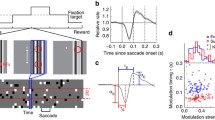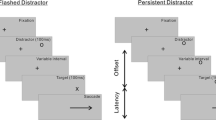Abstract
Three Macaca rhesus monkeys were used for studies of the performance of visually evoked saccades in single-step changes in the position of a stimulus using standard schemes for presentation of GAP-OVERLAP stimuli. Two spatial schemes were used: presentation of stimuli along the horizontal meridian (one-dimensional) and presentation of stimuli within a rectangular area of the visual field (two-dimensional). Asymmetrical foci of short-and long-latency saccades were found in the visual field. Dispersion factor analysis demonstrated that the dimensionality factor (one-dimensional versus two-dimensional stimulation schemes) had greater effects on the latent period of saccades than the lateralization factor (presentation on the left or right sides of the gaze point). The precision of the performance of visually evoked saccades decreased with increases in its eccentricity in both spatial stimulation schemes.
Similar content being viewed by others
References
L. V. Tereshchenko, Asymmetry in Measures of Saccade and Hand Movements in Monkeys in Normal Conditions and Pathology [in Russian], Moscow State University, Moscow (1999).
L. V. Tereshchenko, Yu. B. Kuznetsov, A. V. Latanov, and V. V. Shul’govskii, “A method for the chronic electromagnetic recording of eye and head movements in monkeys,” Zh. Vyssh. Nerv. Deyat., 50, No. 5, 889–894 (2000).
W. Becker and R. Jurgens, “Human oblique saccades: quantitative analysis of the relation between horizontal and vertical components,” Vision Res., 30, 893–920 (1990).
R. Boch and B. Fischer, “Further observations on the occurrence of express-saccades in the monkey,” Exptl. Brain Res., 63, 487–494 (1986).
R. M. Bracewell, M. Husain, and J. F. Stein, “Specialization of the right hemisphere for visuomotor control,” Neuropsychologia, 28, No. 8, 763–775 (1990).
D. Braun and B. G. Breitmeyer, “Relationship between directed visual attention and saccadic reaction times,” Exptl. Brain Res., 73, 546–552 (1988).
M. L. Cheal and D. Lyon, “Attention effects on form discrimination at different eccentricities,” Quart. J. Exptl. Psychol. [A], 41, 719–746 (1989).
H. Collewijn, C. J. Erkelens, and R. M. Steinman, “Binocular coordination of human vertical saccadic eye movements,” J. Physiol. (England), 404, 183–197 (1988).
T. J. Crawford and H. J. Muller, “Spatial and temporal effects of spatial attention on human saccadic eye movements,” Vision Res., 32, 293–304 (1992).
E. de Renzi, A. Colombo, P. Faglioni, and M. Bibertoni, “Conjugate gaze paresis in stroke patients with unilateral damage. An unexpected instance of hemispheric asymmetry,” Arch. Neurol., 39, 482–486 (1982).
H. Deubel and W. X. Schneider, “Saccade target selection and object recognition: evidence for a common attentional mechanism,” Vision Res., 36, No. 12, 1827–1837 (1996).
D. Falk, C. Hildebolt, J. Cheverud, M. Vannier, R. C. Helmkamp, and L. Konigsberg, “Cortical asymmetries in frontal lobes of rhesus monkeys (Macaca mulatta),” Brain Res., 512, 40–45 (1990).
B. Fischer and R. Boch, “Saccadic eye movements after extremely short reaction times in the monkey,” Brain Res., 260, 21–26 (1983).
B. Fischer and E. Ramsperger, “Human express saccades: effects of randomization and daily practice,” Exptl. Brain Res., 64, No. 3, 569–578 (1986).
B. Fischer, “The preparation of visually guided saccades,” Rev. Physiol. Biochem. Pharmacol., 106, 1–35 (1987).
G. M. Galeazzi, C. Mucignat, C. Barbieri, G. Rizzolatti, and C. Umilta, “Orientation strategy implicit in spatial attention,” Boll. Soc. Ital. Biol. Sper., 67, 629–634 (1991).
H. C. Hughes and L. D. Zimba, “Spatial maps of directed visual attention,” J. Exptl. Psychol. (Human Perception), 11, 409–430 (1985).
J. T. Hutton and J. Palet, “Lateral saccadic latencies and handedness,” Neuropsychologia, 24, No. 3, 449–451 (1986).
J. W. Jutai, “Cerebral asymmetry and the psychophysiology of attention,” Int. J. Psychophysiol., 1, 219–225 (1984).
E. Ladavas, M. del Pesce, and L. Provinciali, “Unilateral attention deficits and hemispheric asymmetries in the control of visual attention,” Neuropsychologia, 27, 353–366 (1989).
J. C. Lynch and J. W. McLaren, “Deficits of visual attention and saccadic eye movements after lesions of parieto-occipital cortex in monkeys,” J. Neurophysiol., 61, 74–90 (1989).
G. R. Mangun and S. A. Hillyard, “Spatial gradients of visual attention: behavioral and electrophysiological evidence,” EEG Clin. Neurophysiol., 70, 417–428 (1988).
R. D. Rafal, M. I. Posner, J. F. Friedman, A. W. Inhoff, and E. Bernstein, “Orienting of visual attention in progressive supranuclear palsy,” Brain, 111, 267–280 (1988).
T. Sato, “Effects of attention and stimulus interaction on visual responses of inferior temporal neurons in macaque,” J. Neurophysiol., 60, 344–364 (1988).
J. D. Schall and N. P. Bichot, “Neural correlates of visual and motor decision processes,” Curr. Opin. Neurobiol., 8, 211–217 (1998).
D. Sparks, W. H. Rohrer, and Y. Zhang, “The role of the superior colliculus in saccade initiation: a study of express saccades and the gap effect,” Vision Res., 40, No. 20, 2763–2777 (2000).
D. C. van Essen, W. T. Newsome, and J. H. Maunsell, “The visual field representation in striate cortex of the macaque monkey: asymmetries, anisotropies, and individual variability,” Vision Res., 24, 429–448 (1984).
D. M. Westine and J. D. Enderle, “The generation of horizontal off-center saccades,” Biomed. Sci. Instrum., 27, 171–180 (1991).
Author information
Authors and Affiliations
Additional information
__________
Translated from Zhurnal Vysshei Nervnoi Deyatel’nosti imeni I. P. Pavlova, Vol. 55, No. 5, pp. 639–646, September–October, 2005.
Rights and permissions
About this article
Cite this article
Tereshchenko, L.V., Molchanov, S.A., Kolesnikova, O.V. et al. Asymmetry of the amplitude-time properties of directed saccades in monkeys depending on the complexity of the spatial scheme of visual stimulation. Neurosci Behav Physiol 36, 863–869 (2006). https://doi.org/10.1007/s11055-006-0100-2
Received:
Accepted:
Issue Date:
DOI: https://doi.org/10.1007/s11055-006-0100-2




